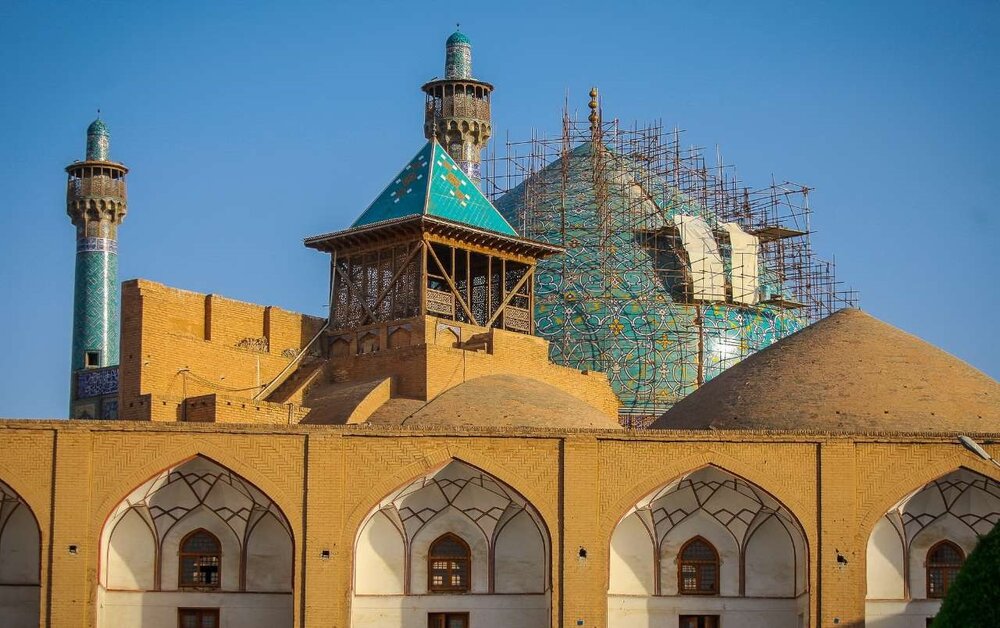Accurate prescription needed for restoration of ancient domes countrywide, official says

TEHRAN – The tourism chief of Isfahan province on Tuesday said many historical monuments in Iran had experienced defects in the restoration of their domes, adding an accurate prescription is needed to prevent from.
Speaking to ILNA, Alireza Izadi said that in the realm of cultural heritage restoration, there have been major problems when it comes to historical domes.
His comments initially concern issues with the dome of Isfahan’s Imam Mosque, which was first publicized in July when pictures posted on social networks brought reactions about the faulty restoration of its massive floral dome.
“Such a threat in the field of restoration is not only directed at Imam Mosque, but also includes many historical domes, so it needs a lot of research in the light of precious expertise of the masters of restoration,” Izadi explained.
“We should compile an accurate prescription for the restoration of the domes. It should not be forgotten that many of the historical domes across the country, such as Soltanieh Dome, have been posed with problems like falling tiles and their replica designs.”
We recently concluded to form a group of cultural heritage and restoration experts of the country to investigate problems with the Imam Mosque, the official said.
Elsewhere in his remarks, Izadi reminded the effect of subsidence on the fate of historical monuments.” Subsidence is evident in many urban areas of Isfahan and even in newly constructed buildings,” he added.
Moreover, he said there was no need to replace all tiles, both worn-out and faultless ones. “It makes no sense to throw away flawless old tiles. In that regard, less than 30 percent of the Imam Mosque’s tiles have been replaced so far.”
According to Izadi, “brick domes such as ones on Imam Mosque or Sheikh Lotfollah Mosque are not an exception to this rule, and its conditions should be fully investigated from a scientific and professional point of view.”
“When a historical building, for example, a dome, is (wholly) surrounded by scaffolding, we cannot visually identify if it is uneven… it cannot be recognized correctly.”
The Ministry of Cultural Heritage, Tourism, and Handicrafts in August set up a special committee to oversee fresh restoration work to be conducted on the dome, which allegedly revealed arrays of faulty tiles when scaffoldings were removed.
Earlier this month, a panel of veteran experts inspected Imam Mosque, whose floral dome has undergone extensive restorations. They advised the cultural heritage body to launch structural monitoring for the 17th-century monument.
A masterpiece of Islamic architecture, Imam Mosque stands tall at the southern end of UNESCO-registered Naghsh-e Jahan Sq. (Imam Square) in Isfahan, central Iran. The majestic place of worship is impressive because of its sheer size and incredible decoration.
Originally named Masjed Shah (“the Shah Mosque”), its construction began in 1611 during the rule of the Safavid King Shah Abbas the Great, who reigned from 1588 to 1629. The mosque’s topmost dome was completed in the last year of his sovereignty.
Many believe each of the mosque’s parts is a work of genius that leaves a lasting impression. This palace of devotion owes its splendor mostly due to being covered with seven-color mosaic tiles and symmetrical calligraphic inscriptions.
The domes are normally double-shelled. While the interior shell is designed to carry the weight of the structure, the exterior shell serves as both a decorative element and as insulation against the elements. The aerodynamic shape of the domes also makes the structures more sustainable.
The Persian tradition of dome-building dates back to the earliest Mesopotamian architecture when domes became an integral part of buildings due to the scarcity of wood in many areas of the Iranian plateau. In Ancient Persia, domes were associated with the divine side of life, as their circular shape represented perfection, eternity, and the heavens.
AM
Leave a Comment